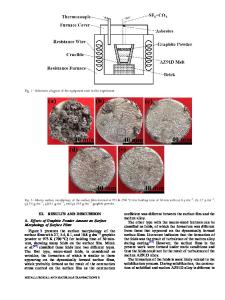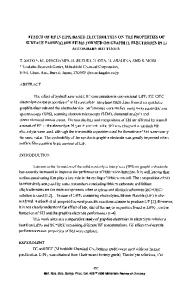Effect of Holding Time on Surface Films Formed on Molten AZ91D Alloy Protected by Graphite Powder
- PDF / 2,213,014 Bytes
- 9 Pages / 593.972 x 792 pts Page_size
- 40 Downloads / 297 Views
ON
MAGNESIUM alloys are widely used in many industries due to their excellent intrinsic properties, such as low density, high specific strength, and rigidity. However, the oxidation of the magnesium during the melting process limits these alloys’ applications. To combat the oxidation problem, certain protective methods are used during the melting and casting process, such as the addition of flux to the melt, protective gases, alloying with ignition proof materials, and vacuum protection.[1,2] In the early stage of oxidation prevention, fluxes are widely used for protecting the magnesium alloys due to their exhibition of effective prevention and ease of application. However, fluxes release harmful gases at WEIHONG LI, JIANHUA WU, and JIXUE ZHOU are with the Shandong Key Laboratory for High Strength Lightweight Metallic Materials, Advanced Materials Institute, Shandong Academy of Sciences, Jinan 250014, China. Contact e-mail: [email protected] BAICHANG MA and JINWEI WANG are with the Shandong Engineering Research Center for Lightweight Automobiles Magnesium Alloys, Advanced Materials Institute, Shandong Academy of Sciences, Jinan 250014, China. YUANSHENG YANG is with the Institute of Metal Research, Chinese Academy of Sciences, Shenyang 110016, Liaoning, China. Manuscript submitted December 14, 2016.
METALLURGICAL AND MATERIALS TRANSACTIONS B
high temperatures, which will not only pose a serious threat to human health but also corrode equipment.[2] Recently, gases, such as SO2,[3,4] SF6,[5] HFC-134a,[6] and HFC125,[7,8] have been used to protect molten magnesium alloys. Unfortunately, the gases bring about environmental problems, because they can cause the greenhouse effect when released into the atmosphere.[9,10] Regarding the alloying method, the addition of the alloying elements significantly deteriorates the mechanical properties of the magnesium alloys.[11] Vacuum protection has no harmful side effects to the environment, but the process raises the cost of magnesium production. The goal, therefore, is to find a cost-effective environmentally friendly solution to prevent the magnesium oxidation. Research has shown that CO2 can protect molten magnesium in different forms and can be used as a substitute for protective gases, not only because CO2 is not toxic or corrosive and is cheaper than SF6 and SO2 but also because it has a lower degree of greenhouse effect than SF6.[12] Fruehling[13] claimed that an atmosphere of pure CO2 gas could effectively protect the magnesium melt. Emami and Sohn[12] used CO2/air gas to protect molten magnesium from oxidation. Yang and Lin[14] used CO2 snow to develop a highly effective method for protecting magnesium melts. Because graphite can react with oxygen to produce CO2 at high temperatures,[9,15,16] which is expected to
act as a barrier for molten magnesium from the atmosphere, the graphite powder is a potential medium for protecting the molten magnesium alloys from oxidation during melting and casting. Surface films formed on molten magnesium under protection of CO2 were composed of Mg
Data Loading...











